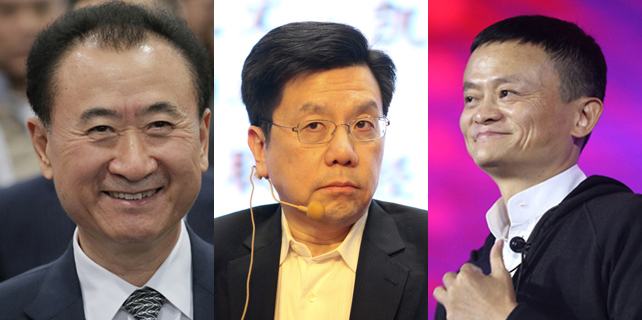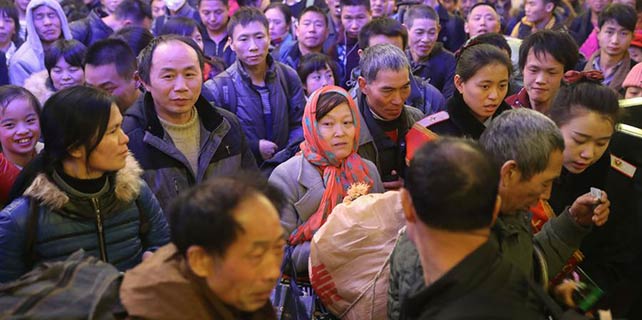Fast Forward
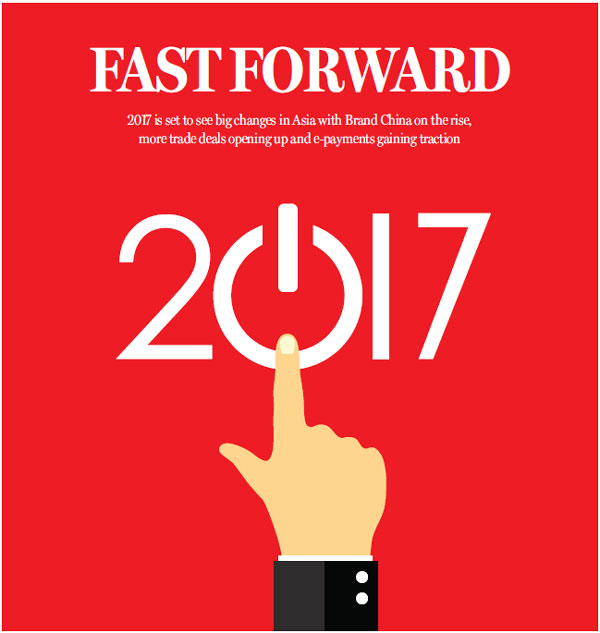
2017 is set to see big changes in Asia with Brand China on the rise, more trade deals opening up and e-payments gaining traction
From new technologies to potential paradigm shifts in the global system of trade, 2017 is certain to be marked by a number of significant evolutions.
Robotics, drones and virtual reality are set to redefine retail. The yuan will continue to operate in a type of new normal, as a recognized part of the global monetary system, while the strength of the US dollar is likely to shape the performance of other currencies and entire markets.
Oil, which over the past few years hit record highs followed by record lows, may slightly strengthen but the age of $100 per barrel may well be over. Electronic payments could take over in Asia and e-commerce will no longer be a curiosity.
As 2017 starts, we examine trends in some key areas likely to play an important role this year in business and economics in Asia and the world.
Advances in technology

Last month, US e-commerce company Amazon made its first commercial delivery by drone in the United Kingdom. And in the weeks beforehand, Alibaba's groundbreaking use of virtual reality shopping during its Singles Day festival gathered global attention. Both examples are only the tip of the iceberg of what is happening in the broad space of robotics, drones and virtual reality.
"This is the year that many Asian countries - China in particular, given its still-dominant position in global manufacturing supply chains - will finally come to terms with the need for process automation in manufacturing," said Ross O'Brien, lead economist at Intercedent, an Asia-focused consultancy.
"This will mean that China, which has fully embraced robotics, will begin to claw back manufacturing capacity from Southeast Asia, which historically and currently harbors systemic resistance to automation."
Mario Artaza, chief representative at Banco Security, a Latin American bank that is expanding across Asia, said: "Exciting times are just around the corner in the specific areas of science, innovation and the development of technologies aimed at supporting human entrepreneurship."
These technologies could help boost agricultural output, improve marine harvests and drive sustainable fishing and logging.
"Some countries have already taken important steps to develop once-barren lands into areas where products aimed for export are now an important part of their overall agro-industrial equation," said Artaza, who is also Chile's former consul general to Hong Kong.
Through 2017, the changes and developments are likely to come fast and steadily with more use of robots, drones and virtual reality. China should prove to be a big driver of this evolution.
"China will continue to move up in global value chains as it keeps scaling up innovation," said Zhuang Juzhong, deputy chief economist at the Asian Development Bank.
The rise of e-commerce

The enormous success of China's Singles Day, which takes place every year on Nov 11, may have marked something of a coming of age for e-commerce in Asia. Sales hit around $18 billion in 2016.
"China will continue to be the most exciting e-commerce market in the world," said O'Brien from Intercedent.
E-commerce now accounts for about 14 percent of all retail sales in China, according to China Internet Watch. Total online retail sales rose 23.6 percent year-on-year in the third quarter of 2016 to 1.15 trillion yuan ($165 billion). The rise is much higher than the increase in retail sales.
While China is the largest e-commerce market in the world and will likely continue to grow, other Asian markets are following in its wake.
Despite this, the penetration of e-commerce in some markets remains shallow. The average across Asia Pacific is around 3 percent, according to a survey by Google and consulting firm Bain & Company of consumers in Indonesia, Malaysia, the Philippines, Singapore, Thailand and Vietnam.
This suggests plenty of room for growth. And, given the ubiquitous nature of digital adoption in the region, growth is certain.
"We wouldn't talk about e-commerce as a topic because it is already part of everyone's daily life. It is not a separate category anymore," said Joe Ngai, a director and managing partner in Hong Kong for consultancy McKinsey & Company.
Sharing economy to soar
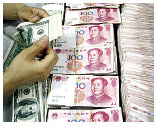
Asia is playing an increasingly important role in the global economy. It "will remain the fastest-growing region in the world and will contribute about 60 percent to global growth", said Zhuang of the ADB.
It now accounts for more than a third of global economic output, with China and India alone responsible for about two-thirds of the world's GDP growth. A rising percentage of all that activity is likely to come from the growing sharing economy.
From car-sharing and taxi-hailing apps in China and elsewhere in Asia, to the growing popularity of Airbnb, crowdfunding and more, the sharing economy is expanding across Asia.
Sharing is already visible throughout the tourism industry, which is growing faster in Asia Pacific than in any other region.
According to a survey by the Pacific Asia Travel Association and tourism research agency TCI Research, more than one in five of the 279 million international travelers from Asia Pacific stayed in sharing accommodation in 2015.
And yet, 90 percent of all sharing companies are in North America and Europe, which leaves plenty of room for such services to grow in Asia. Service platforms like Singapore's Travelmob or Indonesia's Seekmi are growing rapidly, and more are likely to emerge in 2017.
The yuan's ongoing march
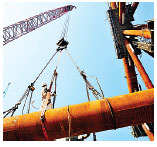
There are various estimates of how the yuan will fare by the end of 2017, but most analysts expect the currency to be lower than it is now, at least against the US dollar.
Now trading at a little below 7 yuan to the dollar, the Chinese currency could end the year at 7.10 yuan. Chua Han Teng, a senior Asia country risk and financial markets analyst at BMI Research, said the firm believes that the Chinese yuan will remain in a bear market against the US dollar.
The ADB's Zhuang expects the volatility in the value of the yuan to continue.
"Given that China's fundamentals remain strong, there's no basis for significant depreciation of the RMB," Zhuang told China Daily. It is difficult to "clearly predict" where the People's Bank of China will take the yuan in the coming months, he added.
The yuan is likely to continue cementing its position as one of the most used currencies of trade and finance but the growth is slowing somewhat, particularly as the dollar gains strength.
In its November RMB Tracker, SWIFT, a provider of payment services, said the use of the yuan in global payments and trade finance has been declining.
"The general slowdown of the Chinese and world economies over the past few years has impacted global trade growth across all currencies, not just the RMB," said Michael Moon, SWIFT's head of payments markets in Asia Pacific.
On the other hand, "the inclusion of the RMB in the special drawing rights basket should generate further trust and confidence in the RMB currency and support further RMB internationalization".
Strong dollar, interest rates

The US Federal Reserve ended 2016 with a hike of 0.25 percent to its federal funds rate and pointed out that it could repeat the move three times this year.
"Policymakers displayed a more hawkish path to monetary policy in 2017, increasing the median expectation to three 25 (basis point) hikes from two in September," said Leonidas Mourelatos, US sub-national analyst at BMI Research, in a note.
The ultimate goal of the Fed appears to be an interest rate of 3 percent, but that may take some more years. As a result of the increase at the end of 2016, bond yields surged and the value of the dollar rose, not always with great effect on equity markets.
More of the same is likely for this year.
"The US dollar will remain a strong currency," said Zhuang. "Given its robust labor market and the prospect of new fiscal stimulus measures to be introduced by the incoming government - tax cuts and infrastructure investment - there could be two to three hikes in the (US Federal Reserve) rate, each of 25 basis points."
Oil: Where is it going?
There is enough oil out there to keep prices low through 2017, although likely a little above the unusually low prices that marked last year. A new deal reached by the Organization of the Petroleum Exporting Countries in late 2016 could shore up prices to some degree but plentiful supplies are likely to cap any hikes.
"Oil prices could be higher in 2017," said the ADB's Zhuang. "A likely range is $50 to $60 per barrel on average."
The move by OPEC countries to curb production alongside non-OPEC countries at the end of last year could help tighten global markets, said Christopher Haines, head of oil and gas at BMI Research.
"If effectively implemented, we expect the global oil market to return to balance in (the first quarter of 2017), thereby accelerating the drawdown in global crude stockpiles," said Haines in a note.
One important shift that is likely to fully catalyze in 2017 is "the adoption of higher fuel standards, with both China and the US moving toward Euro-V equivalent standard," said Haines, referring to European emission requirements.
The sheer size of the two countries is likely to have a huge impact on fuel efficiency and the consumption of cleaner fuels. BMI expects the US and China together will account for half of all gasoline and 28.5 percent of diesel consumed around the world.
Belt and Road picks up pace
President Xi Jinping's Belt and Road Initiative is set to pick up further steam in 2017 as more projects are launched.
The aim of the Belt and Road is to drive trade among the more than 60 participating countries and further afield by developing an overland and a maritime Silk Road.
The Belt and Road got a boost at the beginning of 2016 when the China-led Asian Investment Infrastructure Bank (AIIB) kicked off operations. At a time when countries are considering more trade barriers, the Belt and Road could give global markets a much needed lift.
"I am very encouraged by China's Belt and Road Initiative and am looking forward to supporting placing Latin America in its goals for increased trans-Pacific interaction and development," said Artaza from Banco Security.
Latin America is at the far end of the potential scope of this massive initiative but it is hardly the only region or economy looking to benefit. For countries in the Association of Southeast Asian Nations as well as South and West Asia, the Belt and Road could drive huge investments in infrastructure.
Speaking in December during a China Daily Leadership Roundtable, Stephen Ng, chairman of the Hong Kong General Chamber of Commerce, underlined the importance of the initiative.
"Belt and Road is an ambitious initiative and promises to present a new frontier for growth at a time when growth is sadly lacking," Ng said.
Chinese prop up property
As 2016 came to a close, China's real estate market finally appeared to be slowing down. This is in large part due to tight foreign exchange control measures to curb capital outflows which have been in place since November. With that said, investment is likely to continue and consolidation appears to be on the cards for 2017.
"Major local Chinese developers continue to increase their pace of acquiring existing development sites and completed buildings from smaller developers and investors, particularly those in tier-one cities," said Rico Chan, real estate partner with Baker & McKenzie.
"Foreign investors (particularly those with shorter investment horizons) seem to be quite concerned about the RMB currency depreciation trend," Chan added.
Foreign investors also seem to focus on profits in the near term, Chan said, "even though they are not unnecessarily gloomy about the longer-term business prospects for their projects and investments in China".
The way Ngai from McKinsey sees it, "the real estate industry remains a very important part of the economy in China and its steady economic contribution is critical for the soft landing of the Chinese economy".
Chinese investors are also propping up real estate prices around the world by, in O'Brien's words, "paying for condos from Luanda (in Angola) to Burbank (in California)". As long as this buying spree continues, a crash is unlikely.
Brand China extends reach
The ongoing global expansion that Chinese corporations have undertaken for almost two decades is likely to continue in 2017, even as China continues a grand national branding exercise.
The year ahead should be an interesting one. China-led initiatives like the Belt and Road and the Asian Infrastructure Investment Bank, with its $100 billion chest, are set to raise the profile of the country's global brand.
At the same time, China's growing stable of global corporations is becoming increasingly visible overseas. Lenovo, Haier, Huawei and China Mobile are well established brands.
Others are just as established but less well known, such as Dalian Wanda, which is making large inroads in global real estate and entertainment markets, medical device maker Mindray and vaccine maker Sinovac.
"At a geopolitical level, everybody likes highways and high-speed railways in their stockings at Christmas time," said O'Brien.
He noted, that at an enterprise level, Japan's Docomo and SoftBank are testing their 5G networks with Chinese companies Huawei and ZTE, not Japan's NEC or Fujitsu.
"If the most insular telecoms market on the planet accepts Huawei's playbook, Brand China can drop the mic."
The growth of Brand China is not only likely to continue through 2017 but expand.
"Made in China accelerates to Owned by China as the rest of the world continues to wrestle with how to think about having Chinese owners," said Ngai of McKinsey.
End of free trade?
With more inward-looking governments, growing support for protectionist policies and more trade barriers, uncertainty around the benefits of free trade has increased, said Zhuang of the ADB. The impact of this uncertainty could be a theme through 2017.
"The world needs free and open trade as well as the movement of people to bring about more opportunities and prosperity," said Artaza of Banco Security. "It is ironic that we are willing to make dozens of new friends a week through social media but are afraid at times to have their products at our table, even if these are cheaper and of a better quality."
And yet, the distrust of free trade may continue to expand in countries like the US and the UK and some emerging markets that are unsure of their competitive ability.
"It was always thus," said O'Brien. "Non-tariff barriers have been a fixture of technology exports for decades - and all the bilateral agreements in the world haven't dampened them."





